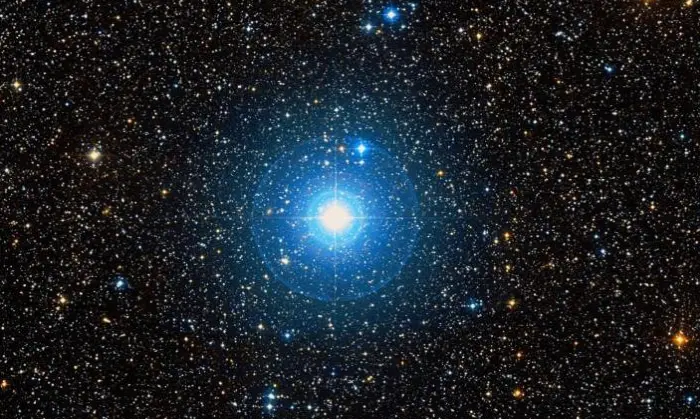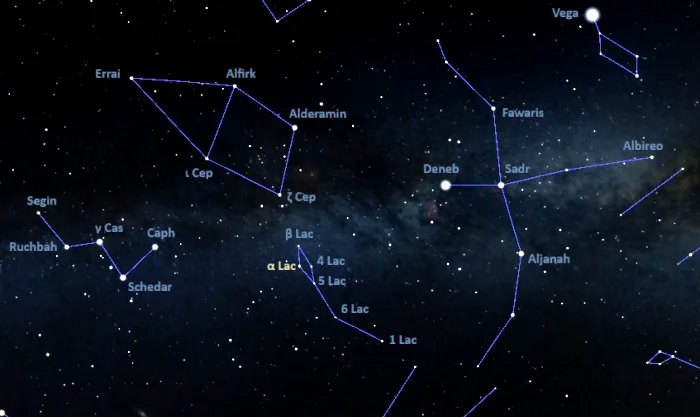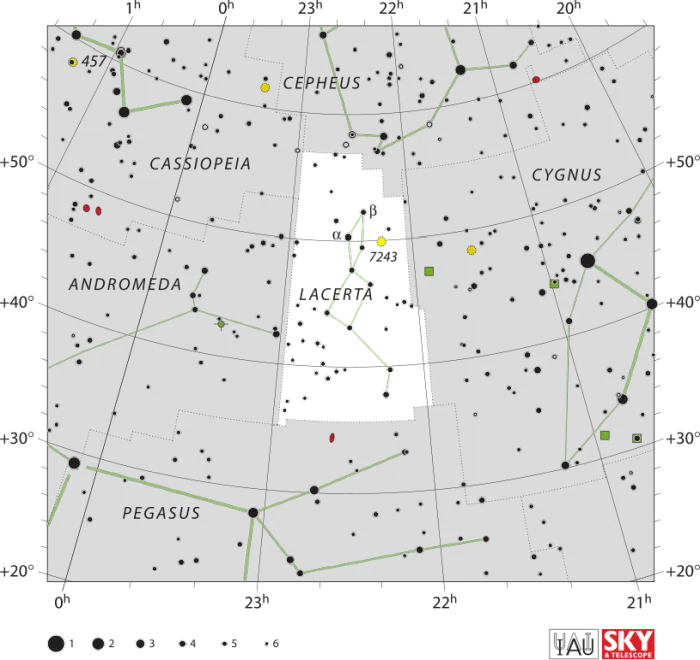Stellio, Alpha Lacertae (α Lac), is a white main sequence star located 102.6 light-years away in the northern constellation of Lacerta. With an apparent magnitude of 3.76, it is the brightest star in Lacerta. It forms the Lizard’s head with Beta Lacertae and 9 Lacertae.
Star type
Alpha Lacertae is a hydrogen-fusing dwarf of the spectral type A1 V. It has a mass 2.194 times that of the Sun and a radius of 2.1432 solar radii. With an effective temperature of 9,050 K, it is 27.675 times more luminous than the Sun. The star is believed to be around 400 million years old.
Alpha Lacertae is a very fast spinner, with a projected rotational velocity of 128 km/s. It is moving in the direction of the Sun with a radial velocity of -12.66 km/s.
Stellio has an optical companion, an A-type star with an apparent visual magnitude of 11.8, at a separation of 36 seconds of arc. The star is listed as ADS 16021 B in the Aitken Double Star Catalogue and CCDM J22313+5017B in the Catalogue of Components of Double and Multiple Stars (CCDM). However, it is not physically associated with Stellio. It only lies in the same line of sight.
Even though it is relatively faint for a constellation’s brightest star, Alpha Lacertae is not the faintest of the 88 lucidae. There are well over a dozen fainter ones, including Kitalpha (Alpha Equulei, mag. 3.919) in the constellation Equuleus, Dalim (Alpha Fornacis, mag. 3.85) in Fornax, Anser (Alpha Vulpeculae, mag. 4.40) in Vulpecula, Praecipua (46 Leonis Minoris, mag. 3.83) in Leo Minor, and the faintest one, Hoerikwaggo (Alpha Mensae, mag. 5.09) in the constellation Mensa.

Stellio (Alpha Lacertae), image credit: ESO/Digitized Sky Survey 2 (CC BY 4.0)
Name
Stellio was the original name of the constellation Lacerta. It is Latin for “star lizard.” Polish astronomer Johannes Hevelius, who created the constellation in 1687, named it after the starred agama (Laudakia stellio), a lizard with star-like spots.
The International Astronomical Union’s (IAU) Working Group on Star Names (WGSN) approved the name Stellio for Alpha Lacertae on August 29, 2024.
The Bayer designations Alpha Lacertae and Beta Lacertae were given to the two Lacerta stars by the English astronomer Francis Baily in his British Association Catalogue in 1845. The constellation Lacerta did not yet exist when German astronomer Johann Bayer assigned the Greek letter designations to 1,564 brighter stars in his star atlas Uranometria of 1603. Alpha and Beta Lacertae are the only stars in Lacerta that have Bayer designations.
In old Chinese astronomy, Alpha Lacertae was known as 螣蛇一 (Téng Shé yī), the First Star of Flying Serpent. It formed the Flying Serpent asterism with 21 stars in the constellations Lacerta, Cygnus, Cepheus, Cassiopeia, and Andromeda. The asterism was part of the larger Encampment mansion, one of the northern mansions of the Black Tortoise.
Location
Alpha Lacertae lies in the northern part of Lacerta and is part of the faint constellation figure of the celestial Lizard. It is the second northernmost relatively bright star in Lacerta’s zig-zag pattern. It lies almost halfway between Schedar (Alpha Cassiopeiae) in the constellation Cassiopeia and Aljanah (Epsilon Cygni) in Cygnus. Schedar is the bottom right star of Cassiopeia’s W asterism, and Aljanah is part of the Northern Cross, a prominent pattern in Cygnus.
At declination +50°, Stellio is best seen from the northern hemisphere. It never rises for observers south of the latitude 39° S.

Alpha Lacertae location, image: Stellarium
Constellation
Stellio lies in the constellation Lacerta. The celestial Lizard is one of the smallest and faintest northern constellations. Introduced by the Polish astronomer Johannes Hevelius in his catalogue of 1687, it occupies only 201 square degrees between the brighter and larger Andromeda, Cassiopeia, Cygnus, Cepheus, and Pegasus.
Stellio, the constellation’s brightest star, is the only star brighter than magnitude 4.0 in Lacerta. It was added to the constellation Lacerta by the English astronomer John Flamsteed, along with Beta and 9 Lacertae. The three stars of the Lizard’s head formed the turban of Cepheus in Hevelius’ depiction of the constellation.
Other notable stars in the constellation include the orange giant or bright giant 1 Lacertae, the red supergiant 5 Lacertae, the G-type red clump giant Beta Lacertae, the triple star HD 211073, the orange giant 11 Lacertae, the massive blue binary star 2 Lacertae, the red supergiants Tengshe (V424 Lacertae) and U Lacertae, the blue supergiant 4 Lacertae, the variable triple star AR Lacertae, the nearby red dwarf EV Lacertae, and Babcock’s Magnetic Star (GL Lacertae, HD 215441), an A-type star with an unusually strong magnetic field.
Deep sky objects in Lacerta include the open clusters NGC 7243 (Caldwell 16), NGC 7209 and NGC 7296, the Great Lacerta Nebula (Sh2-126), ionized by the supernova candidate 10 Lacertae, the nearby Gecko Nebula, the variable extragalactic active galactic nucleus BL Lacertae, the spiral galaxy NGC 7197, and the elliptical galaxy 3C 452.
The best time of the year to see the stars and deep sky objects in Lacerta is during the month of October, when the constellation appears higher above the horizon in the early evening. The entire constellation is visible from locations north of the latitude 40° S.

Lacerta constellation map by IAU and Sky&Telescope magazine (Roger Sinnott & Rick Fienberg) (CC BY 3.0)
The 10 brightest stars in Lacerta are Stellio (Alpha Lac, mag. 3.76), 1 Lacertae (mag. 4.15), 5 Lacertae (mag. 4.36), Beta Lacertae (mag. 4.43), 11 Lacertae (mag. 4.46), HD 211073 (mag. 4.50), 6 Lacertae (mag. 4.52), 2 Lacertae (mag. 4.53 – 4.56), 4 Lacertae (mag. 4.55), and 9 Lacertae (mag. 4.64).
Stellio – Alpha Lacertae
| Spectral class | A1 V |
| U-B colour index | 0.00 |
| B-V colour index | 0.031 ± 0.003 |
| R-I colour index | −0.03 |
| Apparent magnitude | 3.76 |
| Absolute magnitude | 1.27 |
| Distance | 102.6 ± 0.4 light-years (31.5 ± 0.1 parsecs) |
| Parallax | 31.4943 ± 0.2017 mas |
| Radial velocity | -12.66 ± 0.33 km/s |
| Proper motion | RA: 137.243 ± 0.223 mas/yr |
| Dec.: 17.540 ± 0.189 mas/yr | |
| Mass | 2.194 M☉ |
| Luminosity | 27.6750 ± 0.2138 L☉ |
| Radius | 2.1432 ± 0.0737 R☉ |
| Temperature | 9,050 ± 157 K |
| Age | 400 million years |
| Rotational velocity | 128 km/s |
| Surface gravity | 4.27 ± 0.14 cgs |
| Constellation | Lacerta |
| Right ascension | 22h 31m 17.5014213452s |
| Declination | +50° 16′ 56.969913082″ |
| Names and designations | Stellio, Alpha Lacertae, Alpha Lac, α Lacertae, α Lac, 7 Lacertae, 7 Lac, HD 213558, HR 8585, HIP 111169, SAO 34542, FK5 848, CEL 5482, BD+49°3875, AG+50 1825, PPM 40777, PLX 5449.00, GC 31471, GCRV 14154, GSC 03628-03193, GEN# +1.00213558, SKY# 42852, PMC 90-93 595, AKARI-IRC-V1 J2231175+501657, CSI+49 3875 1, HGAM 1070, JP11 3504, IRAS 22292+5001, 2MASS J22311751+5016571, UBV 19265, UBV M 26455, ROT 3281, uvby98 100213558, N30 4963, TD1 29152, TIC 468816607, WEB 19894, TYC 3628-3193-1, Gaia DR2 1988193348339562880, Gaia DR3 1988193348344678656, ADS 16021 A, CCDM J22313+5017A, IDS 22272+4946 A, WDS J22139+3943, WDS J22313+5017A |